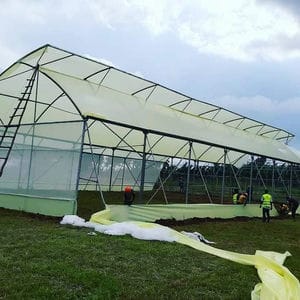The Impact of Greenhouse Polythene in Kenya: Quality Cover, How It Works, Price, Application, and Importance
- Food security and nutrition are essential for Kenya's vision 2030.
- Polythene greenhouses maximize the limited land resource and erratic weather patterns to achieve food security.
- This article summarizes the impact of greenhouse polythene in Kenya.
What is a Polythene Greenhouse?
- Made from prefabricated metallic or treated wooden frames covered by ultraviolet-stabilized polymer films.
- Polythene is durable, doesn’t corrode, and can withstand extreme temperatures.
- High transmission and diffusion of light, allows up to about 200mm of water, and has high ultraviolet blocking or transmission.
- Comes in yellow or milky colours.
- Easy to place and remove or relocate and can also be reused or recycled.
How greenhouse polythene Works
- Drip irrigation is used, where water is directed straight to the plant's roots in the soil through perforated plastic pipes.
- Little water used makes it easy to control, no soil erosion, and evenly distributed in the greenhouse.
- More control over the use of pesticides and fertilizers which is easy to calculate, measure and budget.
- Diseases do not easily spread from one on-farm to another because polythene provides a barrier between different farms.
Greenhouse polythene Price Application
- Greenhouse structure comes in different sizes depending on need.
- For example, the 8 meters by 30 meters greenhouse with an apex height of 4 meters to 5 meters, will cost about KES 350,000 to construct.
- The greenhouse is supported by drip irrigation, a 1000-litre water tank, and a nursery.
- 8 meters and 15 meters metallic greenhouse with an apex height of 4 meters to 4.5 meters, will cost about KES 220,000 to construct.
Why It Is Important to Use greenhouse polythene in Kenya
- Maximum output on produce per unit area compared to traditional farming methods.
- Ensures optimum use of land, provides better supervision and minimum human labour requirements.
- Drip irrigation is applied which uses little water and thus does not depend on whether trends for growth.
- Practical maintenance and installation instructions.
- Crops and vegetables such as flowers, mushrooms, tomatoes, capsicum, spinach, and cucumbers are examples of plants that do well in greenhouses.
Disadvantages of Polythene Greenhouses
- Expensive to set up and maintain.
- Various types of equipment required for ventilation purposes.
- Prevents natural pollination such as wind and insects.
- Causes over-usage of the land, excessive use of pesticides, and lack of crop rotation.
- Not all plants can be grown in greenhouses.
Conclusion
- Greenhouses increase production levels because of better efficiency of space and inputs and reduce the chance of pests and diseases destroying crops.
- On average, greenhouse farmers earn profits that are higher than the profits for open-field farmers.
- Although there is a positive attitude towards greenhouse technology among small and medium-scale farmers in Kenya, additional attention towards proper farming practices is needed to increase the uptake of greenhouses.



.png)



 20%
20%



HDPE sheet is a widely trusted thermoplastic material known for its impressive durability, chemical resistance, and adaptability across industries. Crafted from high-density polyethylene, it withstands impact, moisture, and harsh environmental conditions, making it ideal for applications in construction, agriculture, and industrial manufacturing. Its lightweight nature allows for easy handling and fabrication, while its non-toxic composition ensures safety in sensitive settings. Recyclable and cost-effective HDPE Plastic Sheet Manufacturers supports both performance and sustainability. Whether used as liners, partitions, or protective surfaces, it delivers reliable solutions where strength and precision are essential.
ReplyDelete